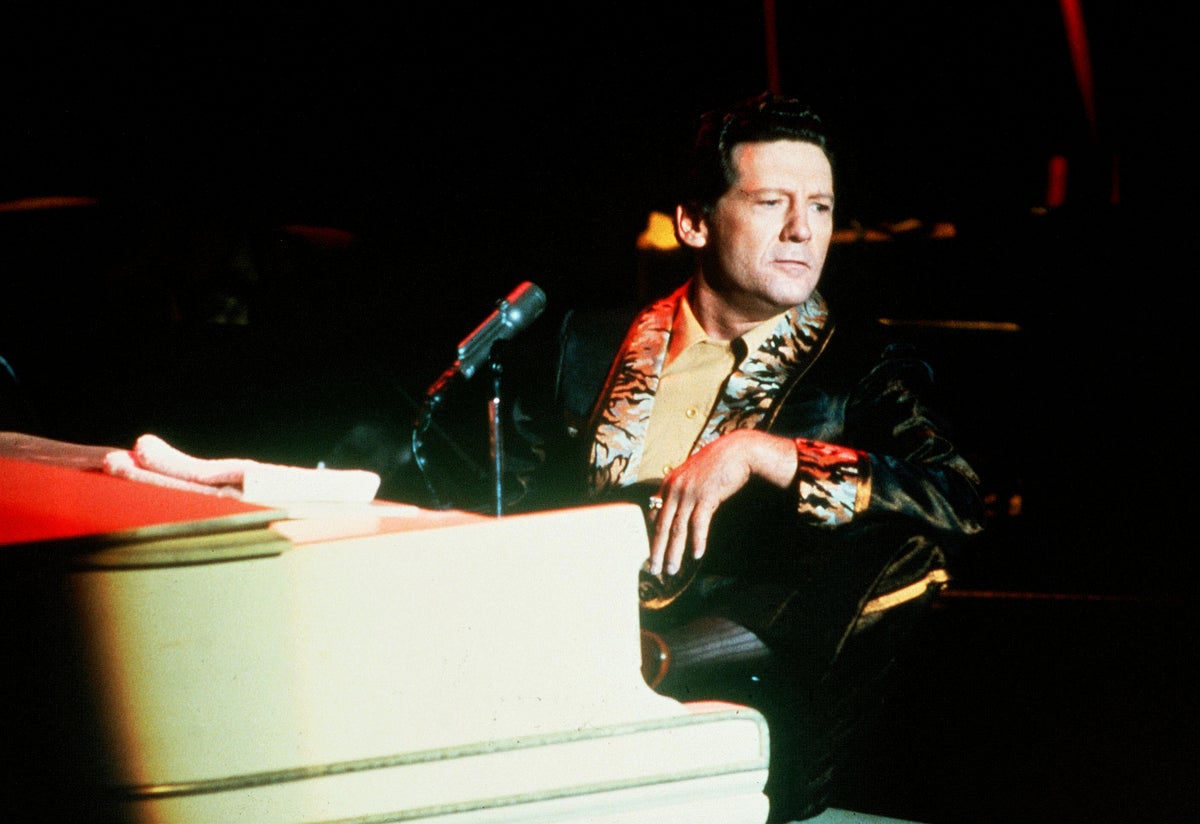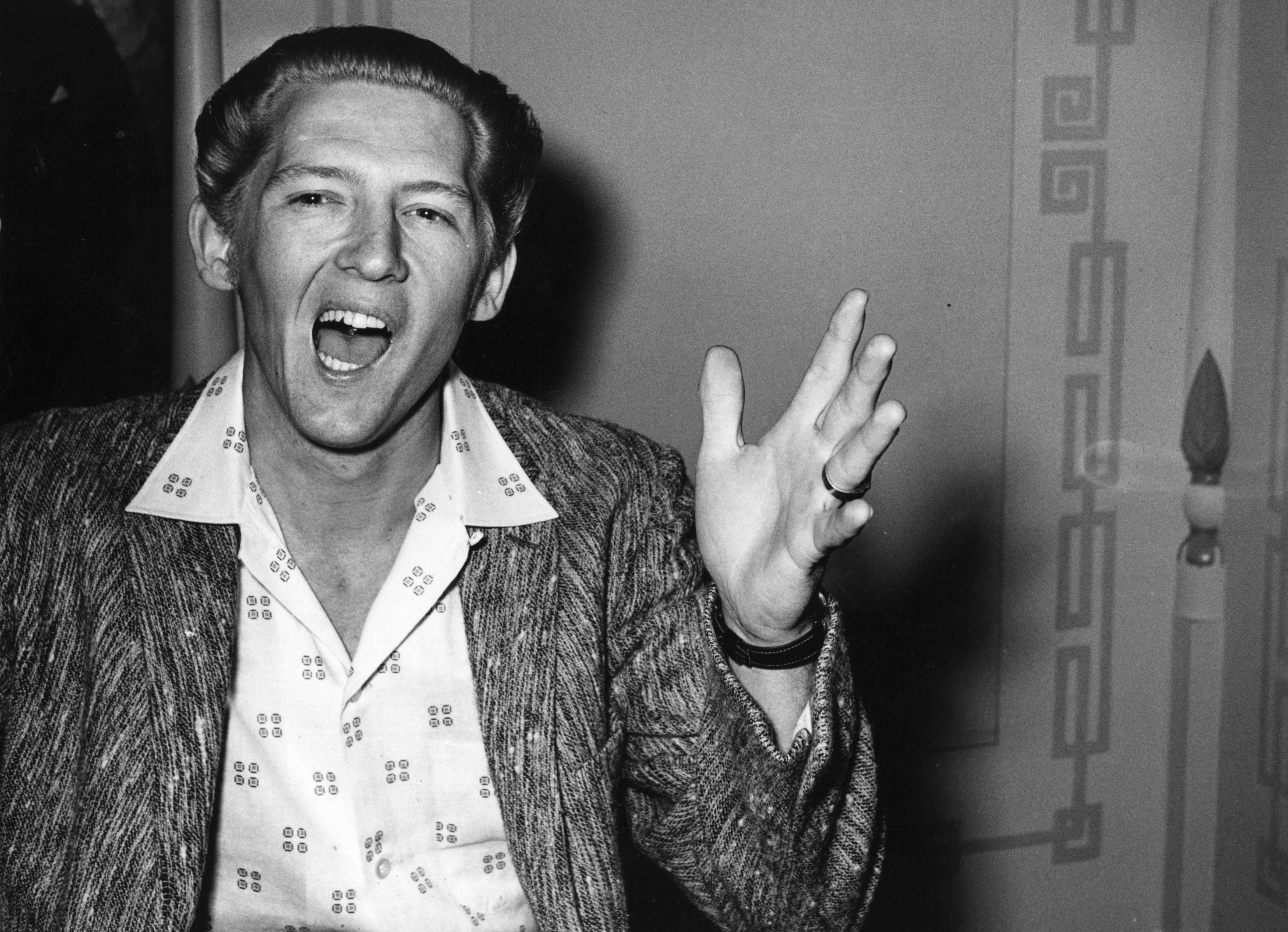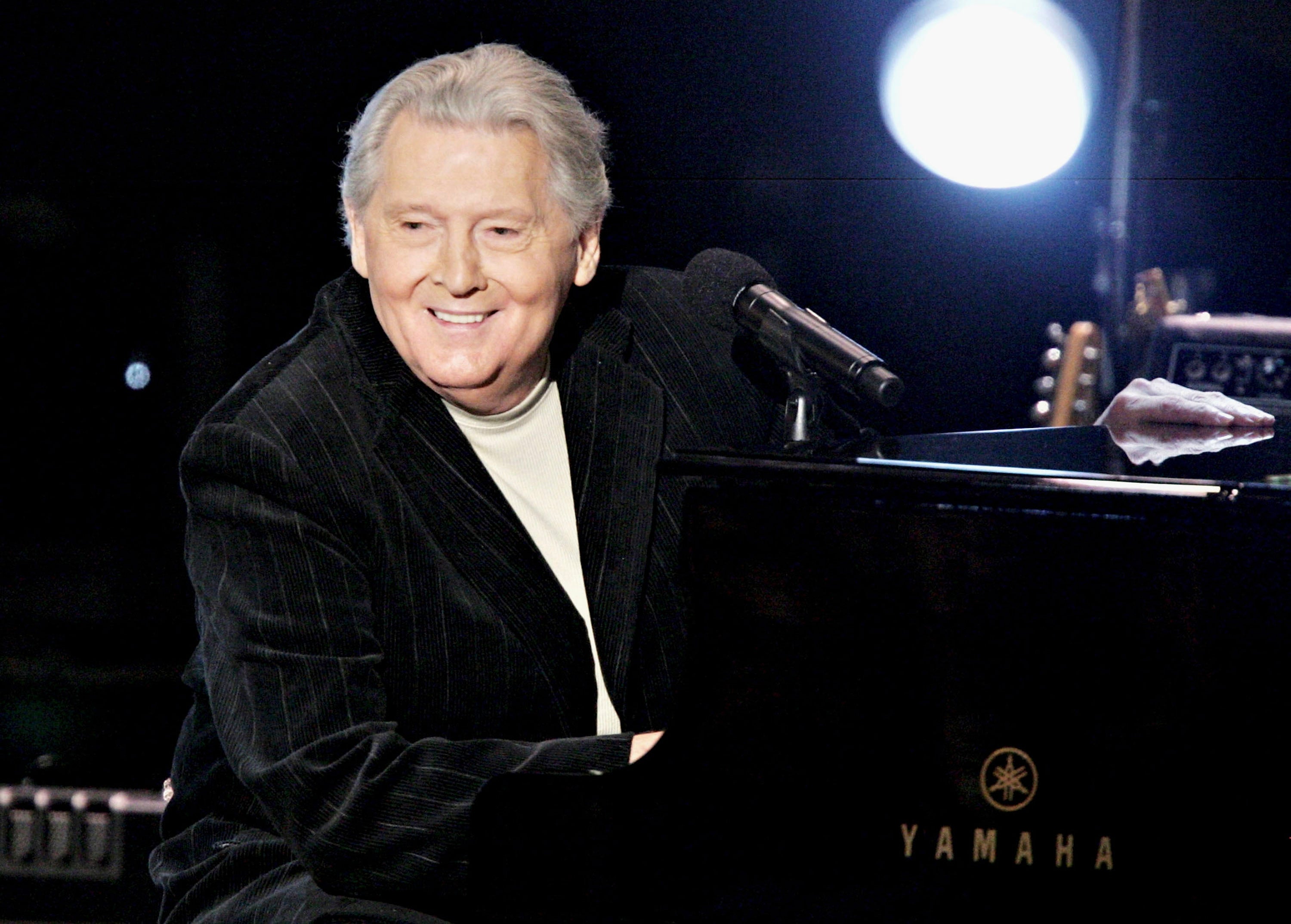
Jerry Lee Lewis was the first of a long line of rock’n’rollers considered to be the antichrist. A song stylist in the grand tradition of Al Jolson, Jimmy Rodgers and Hank Williams, he was an American original, one of the greatest vocal interpreters of the 20th century, able to take any song and make it his own.
However, during a 1958 UK tour at the peak of his fame, he was embroiled in scandal after it was revealed he had married his 13-year-old cousin, Myra Brown – it would be the third of his seven marriages. There was outrage in the British press and the rest of his tour was cancelled. US radio stations and concert promoters also blacklisted him, and his popularity faded. He never again had a US Top 20 hit.
Originally billed as Jerry Lee Lewis and his Pumping Piano, The Killer, as he later became known – an unfortunate sobriquet considering the amount of death that shadowed his life – was a defiantly individual artist whose perpetual teetering on the precipice of tragedy was illuminated and saved by his shimmering brilliance.
Lewis lived a life peppered with pills and potions and laced with lashings of alcohol. It was not until 1995 that he gave up drinking and it was 2004 before he played onstage for the first time since a teenager without the assistance of amphetamines, a drug first recommended to him by Johnny Cash when he started out as a performer.
Born in Ferriday, Louisiana, on 29 September 1935, his sharecropper father had recently emerged from a brief prison term for moonshining alcohol; jailed again for a second offence, he served a five-year stretch during the boy’s early childhood. The southern states of America had been hit hard by the Depression, and grinding poverty led to his father’s pair of prison terms. When he was three, his brother Elmo Jr, also a great musical talent, was killed at the age of eight by a drunk driver: all his life heartbreak would accompany Jerry Lee Lewis.
Lewis’s education was minimal; what schooling he had ended when he was 12, and he never learned how to write a cheque, let alone comprehend his finances. Naive and innocent, with a kind of down-home village mentality, Lewis’s rules of life came largely from the biblical studies he had absorbed from the Assembly of God, a Pentecostal denomination at which his parents worshipped, known for its strict adherence to the Bible as the unerring word of God.
By the time he was 15 this inner fight had raised its head. Married for the first time, to the daughter of a Pentecostal preacher, Lewis was enrolled by his ambitious mother at a minister’s college in Waxahachie, Texas. Sneaking out to nightclubs in Dallas, he was expelled after three months for playing a boogie-woogie version of “My God Is Real” at assembly. He took a job as a vacuum-cleaner salesman but was almost jailed for neglecting to hand over his share of the takings.

By the time he was almost 20, Lewis had been alerted to the new sounds sailing out of the radio, especially those from Sun Records in Memphis. Leaving behind his second wife, whom he had married the same day she gave birth to Jerry Lee Lewis, Jr, his first son, a month before he was divorced from his first bride, he drove up to Memphis in September 1955. At his audition at Sun, Lewis first played a piano instrumental. He then sang a pair of tunes by the new country star George Jones. Although inspired by the recent development of rockabilly, it was country music that lay at the source of Lewis’s style.
In January 1956 Lewis was in the Sun studio to play piano, for $15, on “Matchbox”, a new Carl Perkins single, when Elvis Presley called in on the studio. Also present was Johnny Cash. A jam session started, the engineer having the perspicacity to leave the tape rolling for the session that entered musical legend as The Million Dollar Quartet. Although at first that day it was Presley who played the piano, the novitiate Lewis, eager, full of enthusiasm, subsequently urged him to “scoot over”, rocking up Gene Autry’s “You’re the Only Star in My Blue Heaven”. Presley became a big supporter of Lewis.
It was not until the next year that Phillips would release Lewis’s first sensational international smash, “Whole Lotta Shakin’ Goin’ On”, employing only one microphone and one take, recorded when the studio owner had turned on the tape deck and let the performer go where his emotions took him.

With both “Whole Lotta Shakin’” and his next release “Great Balls of Fire”, also in 1957, Lewis hit the No 1 spot on the US country and western and R&B charts as well as peaking at No 3 and No 2 respectively on the US Billboard Hot 100. As though a portent, Lewis initially had been tormented by the content of “Great Balls of Fire”, refusing to record it, believing it was the work of the devil: the bitter argument between himself and Sam Phillips was included in a number of Sun collections.
The counterpart to such inner religious debate was his breathtaking stage performances, driving his audiences into frenzies as he kicked piano stools and played the instrument with his feet; asked to co-headline with Chuck Berry, with Lewis closing the first half of the show, he avoided being upstaged by setting his piano alight during his final number until the stage itself was in flames. As though to mollify God’s opinion of him, on his second tour Lewis also performed gospel songs, whilst adding the dirtiest lyrics he could imagine to his secular material.
By the summer of 1958, following a 12-day engagement at New York’s Paramount Theatre that broke all attendance records, Lewis seemed on the point of seizing the crown of Presley, who had been called up for military service.
But as his third single “Breathless” moved up the charts in the autumn of that year, his career famously crashed and burned over the revelations about his marriage to a girl so young she still believed in Santa Claus. His UK tour was cancelled after only three dates, and he returned to the US to similar media outrage, compounded by the subject matter of his next single, “High School Confidential”. Soon he was blacklisted on radio and TV, and Lewis hit the road for an endless string of one-night stands.
It took another three years before there was even a glimpse of a return to favour. Still recording for Sam Phillips, in 1961 he released his smouldering interpretation of Ray Charles’s “What’d I Say”, a Top 30 hit in the USA and Top 10 in Britain. In 1963 he quit Sun and moved to the Mercury label; despite selling several million records, Lewis had never collected a royalty from Sun and never sued Phillips. The next year, backed by the Nashville Teens at Hamburg’s Star Club, Jerry Lee Lewis recorded one of the definitive live albums.
Returning to his love of country music, he finally had another million-seller in 1968, on the US country charts with “Another Place Another Time”. Significantly, its follow-up was “What’s Made Milwaukee Famous”. By now, Lewis’s consumption of alcohol and amphetamines had become notorious. But his career as a top-rank country star gave him back much of his former status, as well as a substantial ranch south of Memphis, Tennessee; driving over to visit his old friend Presley in 1975 he drunkenly crashed his Cadillac into the gates of Graceland, and was arrested for waving a pistol and calling out to Elvis to “come out and get your butt whipped”.

In 1986, Lewis was named as part of the Rock and Roll Hall of Fame’s inaugural class and was inducted alongside other groundbreaking performers including Presley, Chuck Berry, James Brown, Buddy Holly and Little Richard, all of whom predeceased him.
“The Rock & Roll Hall of Fame has lost its last inaugural inductee,” the organisation tweeted on his death. “Jerry Lee Lewis sang and played the piano with wild abandon, setting the world on fire with his electrifying performances and rebellious persona. His hits ‘Whole Lotta Shakin’ Goin’ On’ and ‘Great Balls of Fire’ served as a foundation of the sound and spirit of youth culture.
“Jerry Lee was a genuine pioneer, and his music and rock and roll swagger lives on forever.”
Just 12 days before his death, Lewis was finally inducted into the Country Music Hall of Fame, the organisation noting that between 1968 and 1981, he had racked up no fewer than 34 Top Twenty country hits.
Yet the cartoon-like caricature he seemed to have become obscured the seemingly ceaseless tragedies in Lewis’s life. Steve Allen Lewis, the son born to him by Myra, had drowned in a swimming pool in 1962 when the boy was three. In 1971 his marriage to Myra, the love that had wrecked his career, ended in divorce.
Two years later Jerry Lee Lewis Jr was killed in a car crash. Lewis’s next marriage, to Jaren Pate, only lasted two years; she later drowned in a swimming pool, just over a year before the methadone overdose of Shawn Michelle Stevens, his fifth wife, less than three months after they were married in 1983. Girlfriend Bonny Lee Bakley, the mother of Jeri Lee Lewis, born in 1993, was shot to death. Lewis’s 20-year marriage to Kerrie McCarver ended in a messy divorce in 2004.
Lewis himself was not immune to the excesses of his own lifestyle. In 1981 he spent five months in hospital, at first close to death, after his stomach virtually exploded from the ceaseless abuse it had been obliged to endure. Not that Lewis seemed to learn from this brush with death: moving to Dublin for the first half of the 1990s, stories of the musician’s all-night carousing were commonplace.
He had relocated to Ireland to take advantage of the country’s generous tax laws, after having twice been tried by the US IRS for tax evasion. Although on each occasion they had removed his furniture, pianos, cars, motorcycles, jet skis and mechanical bull, he beat both raps – largely by showing how others had run his financial affairs for him – but was still obliged to come up with £2.5m in back taxes.
Back from Dublin at his home in Tennessee, his marriage even rockier than when it started, Lewis largely took to his bed, watching endless re-runs of Gunsmoke, but finally giving up alcohol. At the beginning of the third millennium, the philanthropist Steve Bing decided the world needed another Lewis album, financing the entire independent production himself, perhaps not expecting that the project would take the next five years to complete.
In a considerable and acclaimed return to form, Last Man Standing, which was finally released at the end of 2006, featured Lewis working with innumerable greats: Little Richard, Merle Haggard, BB King, Buddy Guy, Willie Nelson, Jimmy Page and Keith Richards, among others.
In an interview to publicise the record with Charles M Young of Rolling Stone, the musician reflected on the marriage to Myra, his child bride, that had brought down his career. As might almost inevitably have been expected, he proved utterly unrepentant: “I coulda cared less,” he said. “I never hid nothin’ from the world. Sam Phillips warned me to hide it. That was a buncha baloney. I’d be a hypocrite if I did that.”
Jerry Lee Lewis, musician, born 29 September 1935, died 28 October 2022







